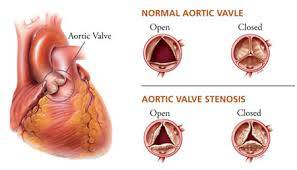NCLEX Aortic Stenosis
NCLEX Aortic Stenosis
Aortic stenosis (AS or AOS) is the narrowing of the exit of the left ventricle of the heart, such that problems result. It may occur at the aortic valve as well as above and below this level. It typically gets worse over time. Symptoms often come on gradually with a decreased ability to exercise often occurring first. If heart failure, loss of consciousness, or heart related chest pain occurs due to AS the outcomes are worse. Loss of consciousness typically occurs with standing or exercise. Signs of heart failure include shortness of breath especially when lying down, at night, or with exercise, and swelling of the legs. Thickening of the valve without narrowing is known as aortic sclerosis.
Signs and Symptoms
Aortic valve stenosis ranges from mild to severe. Aortic valve stenosis signs and symptoms generally develop when narrowing of the valve is severe and can include:
- Chest pain (angina) or tightness
- Feeling faint or fainting with exertion
- Shortness of breath, especially with exertion
- Fatigue, especially during times of increased activity
- Heart palpitations — sensations of a rapid, fluttering heartbeat
- Heart murmur
Causes
- As the aortic valve narrows, the left ventricle has to work harder to pump blood out through the valve. To do this extra work, the muscles in the ventricle walls become thicker. This can lead to chest pain.
- As the pressure continues to rise, blood may back up into the lungs. Severe aortic stenosis can limit the amount of blood that reaches the brain and the rest of the body.
- Aortic stenosis may be present from birth (congenital), but most often it develops later in life. Children with aortic stenosis may have other conditions present from birth.
- Aortic stenosis mainly occurs due to the buildup of calcium deposits that narrow the valve. This is called calcific aortic stenosis. The problem mostly affects older people.
- Calcification of the valve happens sooner in people who are born with abnormal aortic or bicuspid valves. In rare cases, calcification can develop more quickly when a person has received chest radiation (such as for cancer treatment).
- Another cause is rheumatic fever. This condition can develop after strep throat or scarlet fever. Valve problems do not develop for 5 – 10 years or longer after rheumatic fever occurs. Rheumatic fever is becoming rarer in the United States.
- Aortic stenosis occurs in about 2% of people over 65 years of age. It occurs more often in men than in women.
Risk Factors
Aortic valve stenosis isn’t considered preventable, and presently it’s not known why some people develop this condition. Some risk factors include:
- A deformed aortic valve Some people are born with an already narrowed aortic valve or develop aortic valve stenosis later in life because they were born with a bicuspid aortic valve — one with two flaps (leaflets) instead of three. People may also develop aortic valve stenosis if they were born with one leaflet (unicuspid aortic valve) or four leaflets (quadricuspid aortic valve), but these are much more rare conditions.
A bicuspid aortic valve is a major risk factor for aortic valve stenosis. A bicuspid aortic valve can run in families, so knowing your family history is important. If you have a first-degree relative — a parent, sibling or child — with a bicuspid aortic valve, it is reasonable to check to see if you have this abnormality.
- Age Aortic valve stenosis may be related to increasing age and the buildup of calcium deposits on heart valves.
- Previous rheumatic fever Rheumatic fever can cause the flaps (leaflets) of your aortic valve to stiffen and fuse, eventually resulting in aortic valve stenosis.
- Chronic kidney disease Aortic valve stenosis is associated with chronic kidney disease.
Risk factors for aortic valve stenosis and atherosclerotic heart disease are similar — such as high blood pressure, high cholesterol, type 2 diabetes and smoking — which may indicate a link between the two.
Complications
Aortic valve stenosis — of any cause — can be a serious condition. If the aortic valve is narrowed, the left ventricle has to work harder to pump a sufficient amount of blood into the aorta and onward to the rest of your body.
In response, the left ventricle may thicken and enlarge. At first, these adaptations help the left ventricle pump blood with more force. But eventually it’s harder for the heart to maintain the blood flow to the body through the narrowed valve. Then you will start to experience symptoms. Eventually, the extra work of the heart can weaken the left ventricle — and your heart overall.
- Chest pain (angina)
- Fainting (syncope)
- Heart failure
- Irregular heart rhythms (arrhythmias)
- Cardiac arrest
Diagnosis
A heart murmur, click, or other abnormal sound is almost always heard through a stethoscope. The health care provider may be able to feel a vibration or movement when placing a hand over the heart. There may be a faint pulse or changes in the quality of the pulse in the neck.
Blood pressure may be low.
The following tests may also be performed:
- ECG
- ECHO
- Chest X-Ray
- CT Chest
- Exercise stress testing
- Left cardiac catheterization
- MRI of the heart
- Transesophageal echocardiogram (TEE)
Treatments
Treatment is generally not necessary in people without symptoms. In moderate cases, echocardiography is performed every 1–2 years to monitor the progression, possibly complemented with a cardiac stress test. In severe cases, echocardiography is performed every 3–6 months. In both moderate and mild cases, the person should immediately make a revisit or be admitted for inpatient care if any new related symptoms appear. There are no therapeutic options currently available to treat people with aortic valve stenosis; however, studies have indicated that the disease occurs as a result of active cellular processes, suggesting that targeting these processes may lead to viable therapeutic approaches.
Surgical Repair
- Aortic Valve Repair and/or Replacement
- Balloon valvuloplasty
NCLEX National Exam Courses
Overview
- Elite Reviews Offers A Variety Of Online Courses That Will More Than Adequately Help Prepare The Graduate Nurse To Pass The National Exam.
- Each Course Includes Sample Questions & The Most Current NCLEX Exam Updates.
NCLEX Free Trial
- FREE Sample Lecture & Practice Questions
- Available For 24 Hrs After Registration
- Click The Free Trial Link To Get Started – NCLEX Free Trial
How It Works
How The Course Works
- First – Purchase The Course By Clicking On The Blue Add To Cart Button – You Will Then Be Prompted To Create A User Account.
- Second – After Creating An Account, All 3 Options (90, 120, 150 Days) Will Be Listed. Select The Option You Desire And Delete The Other Two.
- Third – You Will Be Prompted To Pay For This Review Using PayPal – After Payment You Will Be Redirected Back To Your Account.
- Last – Click The Start Button Located Within Your Account To Begin The Course
- 175 Prep Questions
- Q & A With Rationales
- Alt. Format Questions
- 90 Days Availability
- Cost $75.00
- 1250+ Prep Questions
- Q & A With Rationales
- Alt. Format Questions
- 90 Days Availability
- Cost $200.00
NCLEX Practice Questions Bundle
- 1350+ Prep Questions
- Q & A With Rationales
- Alt. Format Questions
- 90 Days Availability
- Cost $225.00
NCLEX Review Course
- Option 1
- Lectures & 1250+ Questions
- Q & A With Rationales
- Alt. Format Questions
- 90 Days Availability
- Cost $275.00
- Option 2
- Lectures & 2000+ Questions
- Q & A With Rationales
- Alt. Format Questions
- 90 Days Availability
- Cost $325.00
NCLEX Review Course Bundle
- Option 3
- Lectures & 3000+ Questions
- Q & A With Rationales
- Alt. Format Questions
- 90 Days Availability
- Cost $375.00







